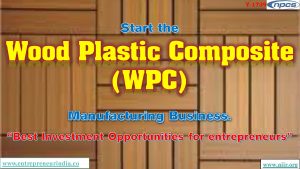
Introduction
WPCs are thermoplastic composite materials consisting of wood fiber/wood flour and thermoplastic(s) such as PE, PP, PVC, or PLA. WPCs may include ligno-cellulosic and/or inorganic filler materials in addition to wood fiber and plastic.
WPCs are a subset of natural fiber plastic composites (NFPCs), which may or may not include cellulose-based fiber fillers such as pulp fibres, peanut hulls, coffee husk, bamboo, straw, digestate, and so on. Chemical additives in the composite structure seem to be virtually “invisible” (except for mineral fillers and pigments, if added).
They allow polymer and wood flour (powder) integration while facilitating optimal processing conditions. People in the flooring industry have begun to refer to WPC as a form of floor with a simple structure of top vinyl veneer plus a rigid extruded core in recent years (the core can be made without any wood fiber).
Related Project: Wood Plastic Composite (WPC)
Uses of Wood Plastic Composite (WPC)
In comparison to the long history of natural lumber as a construction material, wood-plastic composites are still relatively new materials. WPCs are most commonly used in outdoor deck floors in North America, but they are also used in railings, walls, landscaping timbers, cladding and siding, park benches, moulding and trim, prefab houses under the brand name Woodpecker WPC, window and door frames, and indoor fur.
In the early 1990s, wood-plastic composites were first introduced to the decking industry. Wood-plastic composites, according to manufacturers, are more environmentally friendly and need less maintenance than solid wood treated with preservatives or solid wood of rot-resistant species. These materials may be moulded with or without the appearance of wood grain.
Production of Wood Plastic Composite (WPC)
Ground wood particles and heated thermoplastic resin are thoroughly mixed to create wood-plastic composites (WPCs). Extrusion of the material into the desired form is the most common method of manufacturing, though injection moulding is often used. WPCs are made from thermoplastics such as HDPE, LDPE, PVC, PP, ABS, PS, and PLA, which can be virgin or recycled.
WPCs made of polyethylene are by far the most popular. Colorants, coupling agents, UV stabilisers, blowing agents, foaming agents, and lubricants are examples of additives that help customise the end product to the target application field. Strong and hollow profiles are made from extruded WPCs. Injection moulded pieces, ranging from automotive door panels to mobile phone covers, are also made.
The constituents are mixed and processed in a pelletizing extruder in some production plants, which creates pellets of the new material. After that, the pellets are remelted and formed into the final shape. Other manufacturers combine mixing and extrusion into a single phase to complete the finished part.
WPCs are typically manufactured at much lower temperatures than conventional plastics during extrusion and injection moulding due to the inclusion of organic material. WPCs, for example, process at temperatures about 50 degrees Fahrenheit (28 degrees Celsius) lower than unfilled materials. At about 400 °F (204 °C), the majority of them will start to burn. When processing WPCs at extremely high temperatures, the possibility of shearing, or burning and discoloration, arises from forcing a hot material through a narrow gate during injection moulding. The melt flow index (MFI) of a WPC is determined by the ratio of wood to plastic in the composite, with greater quantities of wood usually resulting in a lower MFI.
Related Videos: Plastics Projects
Advantages of Wood Plastic Composite (WPC
WPCs do not corrode and are highly resistant to rot, decay, and marine borer attack, but the wood fibres contained within the material absorb water. Water absorption is more pronounced in WFCs with a hydrophilic matrix, such as PLA, which causes mechanical stiffness and strength to be reduced.
An acetylation treatment can improve mechanical efficiency in a wet environment. WPCs are easy to work with and can be shaped with standard woodworking tools. WPCs are often regarded as a renewable material since they can be manufactured from recycled plastics and wood industry waste. They can, like concrete, be easily recycled into a new wood-plastic composite. One advantage of plastic over wood is its ability to be shaped into almost any desired form. Strong arching curves can be formed by bending and fixing a WPC component. Another advantage of these materials is that they do not require painting. They come in a variety of colours, but greys and earth tones are particularly common.
Related projects: – Project Reports & Profiles
Market Outlook:
The wood-plastic composites market is expected to develop at a CAGR of 12.4% from 2016 to 2021, reaching USD 5.84 billion. The growing demand for wood-plastic composites in the building and construction industry is a major driver of market development.
Between 2016 and 2021, the wood-plastic composites market in Asia-Pacific is expected to expand at the fastest pace. Increased construction activities and investments in the expansion or upgrade of manufacturing facilities have fueled development in China and India’s economies.
The largest economies in Asia-Pacific, China, Japan, and India, have more prospects for the growth of the wood-plastic composites market in the near future. Government initiatives to encourage industrial growth would further aid the growth of the wood-plastic composites industry in these countries.
Market Research: – Market Research Report
Over the last five years, the Indian Composites Industry has developed at a steady pace, serving a diverse range of raw materials, parts, and industries. The Indian composites industry is expected to develop rapidly, with a CAGR of 8.2 percent, to cross 4.9 lakh metric tonnes by 2022. Rebounding renewable energy, growth in mass transportation, penetration of composites in strategic sectors, and a modestly growing index of industrial production could all contribute to this level of growth.
For More Details Click Here: https://www.entrepreneurindia.co/project-and-profile-details/Wood%20Plastic%20Composite